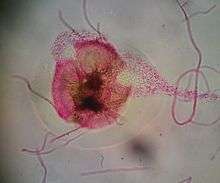Pycnidium
A pycnidium (plural pycnidia) is an asexual fruiting body produced by mitosporic fungi in the form order Sphaeropsidales (Deuteromycota, Coelomycetes). It is often spherical or inversely pearshaped (obpyriform) and its internal cavity is lined with conidiophores. When ripe, an opening generally appears at the top, through which the pycnidiospores escape.[1][2]

Phoma-Coelomycetes Pycnidium
References
- Punithalingam, E. (1966). "Development of the pycnidium in Septoria". Transactions of the British Mycological Society. 49 (1): 19–25. doi:10.1016/S0007-1536(66)80030-X. ISSN 0007-1536.
- Roger, C.; Tivoli, B. (1996). "Spatio-temporal development of pycnidia and perithecia and dissemination of spores of Mycosphaerella pinodes on pea (Pisum sativum)". Plant Pathology. 45 (3): 518–528. doi:10.1046/j.1365-3059.1996.d01-139.x. ISSN 0032-0862.
Further reading
- Kulik, Martin M. "Symptomless infection, persistence, and production of pycnidia in host and non-host plants by Phomopsis batatae, Phomopsis phaseoli, and Phomopsis sojae, and the taxonomic implications." Mycologia(1984): 274-291.
- Calpouzos, L., and D. B. Lapis. "Effects of light on pycnidium formation, sporulation, and tropism by Septoria nodorum." Phytopathology 60.5 (1970): 791-794.
This article is issued from Wikipedia. The text is licensed under Creative Commons - Attribution - Sharealike. Additional terms may apply for the media files.